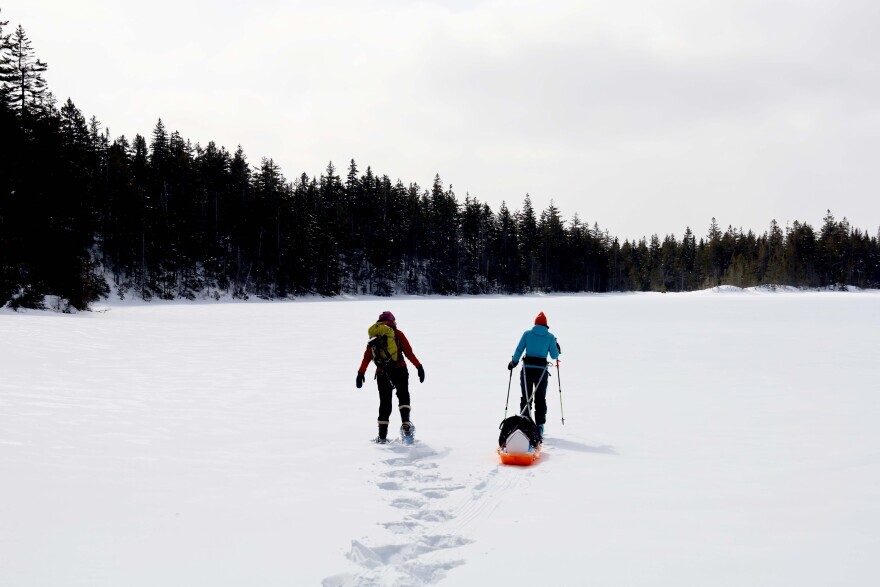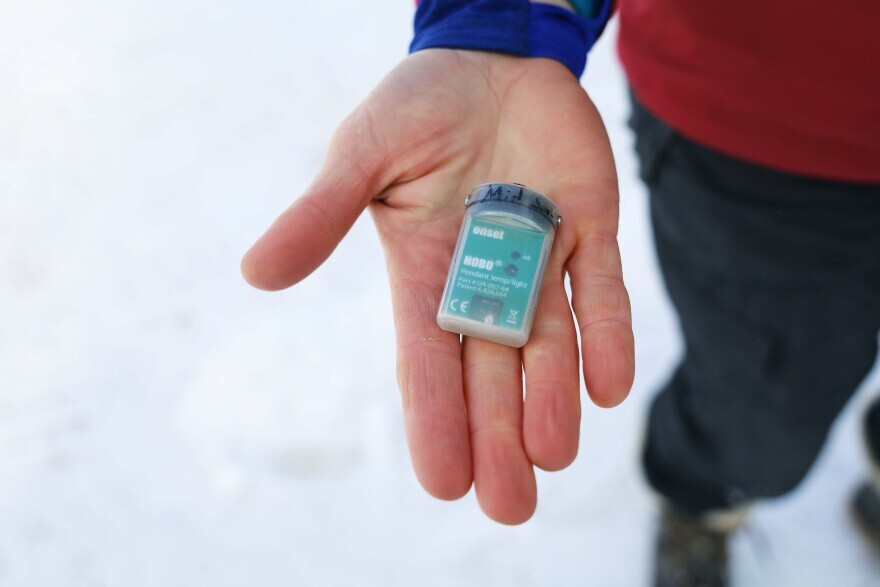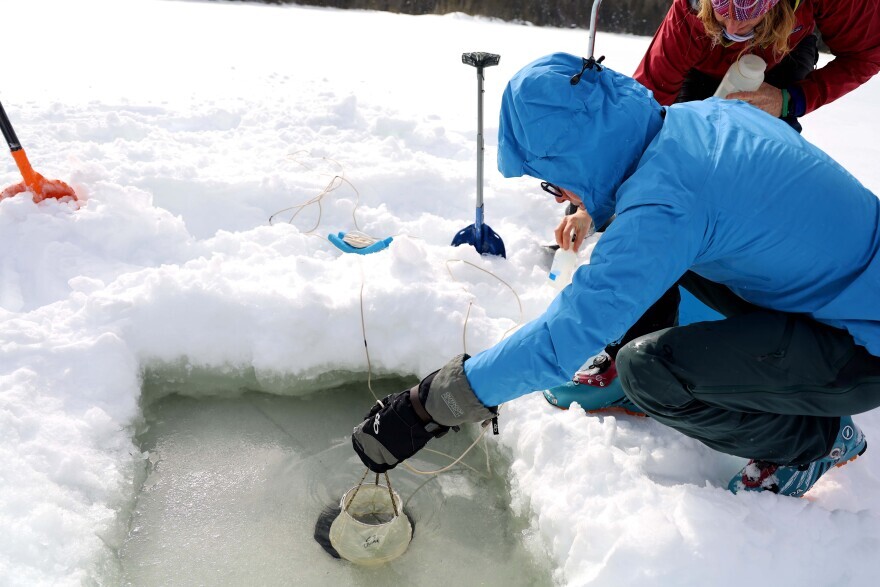Mountain lakes in western Maine may provide a unique refuge for species as the climate warms
On a frigid winter day, University of Maine Farmington professors Julia Daly and Rachel Hovel load up their gear on a sled and head out on skis and snowshoes to Midway Pond near Saddleback Mountain in Western Maine.
While this area is well known for outdoor recreation, scientists are also beginning to learn just how ecologically important it is. And that’s why Daly and Hovel are taking samples here today. Daly is an associate professor of geology, and Hovel is an assistant professor of biology at the University of Maine Farmington, and they’re starting to document the role that these small, high elevation lakes might play as climate change continues to impact the region.
“One thing that makes Franklin County special is that we have all of these winter recreation opportunities. And that’s something that our area’s really known for,” Daly says. “One thing that I think is really important about this research is that it helps us understand how winter is changing.”
Research on these unique ecosystems have lagged, in part, because many of the lakes aren’t easily accessible. Of the eight high-elevation lakes Daly and Hovel research, Midway Pond is easiest to get to.
After hiking a mile and a half through thick snow up a gradual slope, they arrive at a pristine, snow-covered lake.

Julia Daly, left, and Rachel Hovel arrive at Midway Pond near Saddleback Mountain in Franklin County. Hovel pulls a sled full of gear they will use to take samples from the water. (Esta Pratt-Kielley/Maine Public)
Hovel uses GPS coordinates to identify the precise location of a buoy, which Daly placed in the water a decade ago, when she first began researching ice-out dates at the lake. It holds sensors that measure water circulation, temperature, and ice dynamics year-round.
“Winter is the time of year that’s changing the most in Maine. Fall is occurring later spring is happening earlier,” Hovel says. “And our ability to monitor using the buoy throughout the year it gives us a good window into that.”
Every summer, Daly brings students to Midway Pond and their other research sites to collect the sensors form the buoy and replace them with new sensors. They then bring the sensors back to the lab so they can analyze the data they’ve collected over the year.

These sensors are attached to a buoy in the lake, and they measure water circulation, temperature, and ice dynamics year-round. (Esta Pratt-Kielley/Maine Public)
After Daly and Hovel locate the sensors, they begin clearing a space with shovels so they can put a hole in the ice using a hand auger – the same tool used for ice fishing.
Then, Hovel slowly lowers an instrument called a multi parameter sonde into the hole. Every second it records temperature and dissolved oxygen. It also measures the concentration of phytoplankton, which are microscopic plant organisms.
“There’s still a lot of activity happening and we’re starting to get a better understanding of, for instance, algae phytoplankton growing under the ice,” Hovel says.
Next, Hovel uses a net to gather a sample of zooplankton, or aquatic animal microorganisms.
“It’s definitely pretty quiet,” Hovel says, commenting on the number of zooplankton she can see with the naked eye.
But there’s more happening under the ice than meets the eye. Hovel identifies tiny, red zooplankton swimming around in the sample. When they revisit the site at a warmer time, they’ll be able to compare the level of activity.

Rachel Hovel uses a net to gather a sample of zooplankton from Midway Pond. (Esta Pratt-Kielley/Maine Public)
“In the past few years more people are starting to realize that there’s a lot happening in lakes biologically underneath the ice in the winter. They don’t just shut down,” Daly says.
Hovel says it’s important to find out if high elevation lakes hold potential as “climate refugia” – areas where the effects of rising temperatures are largely buffered because of unique local conditions. In other words, this lake could be a place that remains habitable to organisms in the future, in part because of a thick, insulated snowpack layer over the ice.
“You might have some species that start to feel the effects of warming temperatures at lower elevation sites. But those species might continue to persist at these higher elevation sites, if they can continue to be cooler,” Hovel says.
Researchers and natural resource managers in the northeast are working together to gather baseline data, and Daly and Hovel’s research is beginning to shed light on how to identify and manage “climate refugia.” It’s research that has impact across the state.
“When we think of a changing climate, it’s really important to remember how connected our whole landscape is. All the way from sort of the tops of the mountains all the way out into the Gulf of Maine,” Daly says. “And the information that we’re getting here is giving us an idea about climate responses.”
As the effects of climate change accelerate, these places allow for research into adaptation strategies in the short term, and possible safe havens in the long term.
“One of the signals that we have to be hopeful for is this idea of resilience across the landscape,” Hovel says. “And we know, we have a growing understanding of what gives us that resilience, it seems to be diverse ecosystems, diverse biological communities that have potential to have the right traits for our climate future.”
And Hovel says that’s something that can give Mainers a bit of hope.
This story is part of Maine Public’s series “Climate Driven: A deep dive into Maine’s response, one county at a time.”
